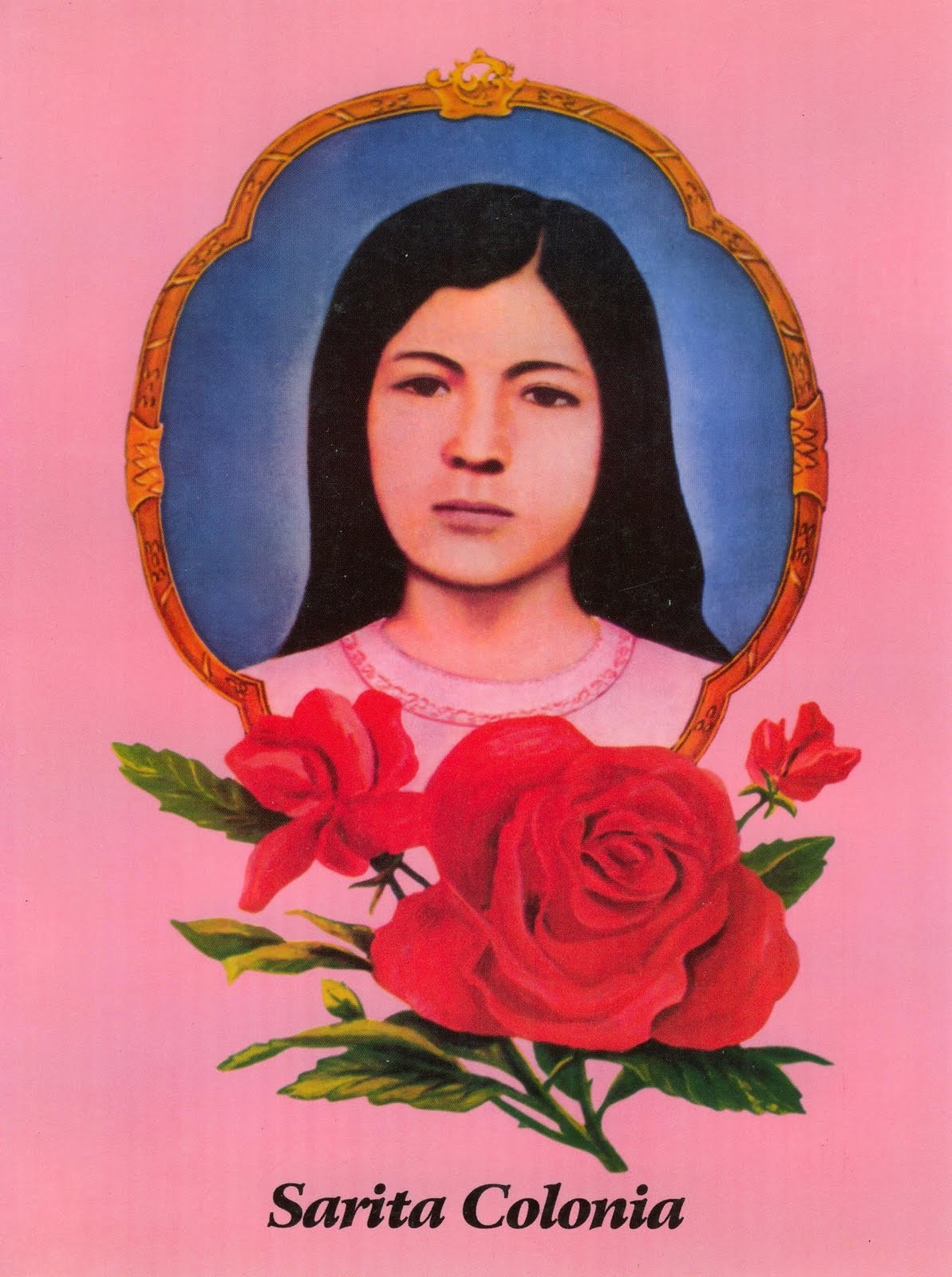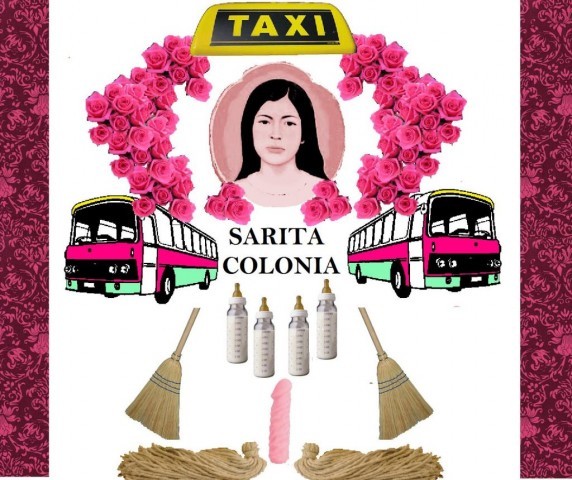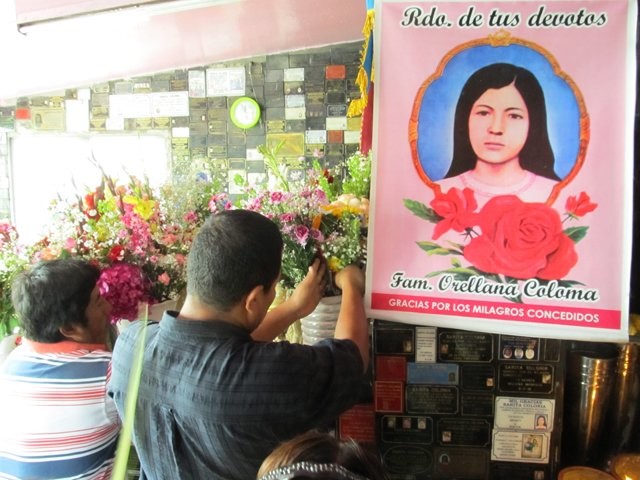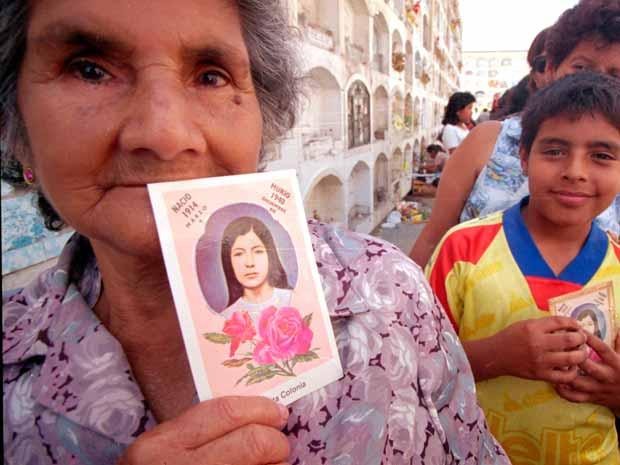Sarita Colonia, patron of the poor
Hello everyone! I hope you're all doing well, today I want to share with you about a very popular character in Peru and especially in Lima, she is not a saint and has not been canonized or anything like that, rather her following has developed throughout the city of Lima and its people. You could say her case is special since the woman about whom I want to speak about was just an ordinary girl who lived in the mid twentieth century. Her popularity and image began as a religious one among the people of marginalized communities, today Sarita Colonia is a person who has surpassed social boundaries and is worshipped in many areas of Lima and Peru.

First of all, I want to clarify that I am not Catholic but as you may have already realized everything related to the history of Peru and especially my city fascinates me greatly and the interesting thing about Sarita Colonia is that she was a regular woman like you or me, that without being official or rather said without being promoted by the Peruvian state, forged a space in the Peruvian popular tradition .
Sarita Colonia is a character that as we will see had many mysteries about her life. She came to Lima looking for a new opportunity. I remember when I was a kid they would play a series about the life of Sarita Colonia on channel 9, this was backl when it was quite popular in Peru to create miniseries' about musical groups or characters of popular recognition and it was during this time that Sarita Colonia came on the small screen so that the new generations of children, like me at the time, could begin to know her and to learn about her history. Of course there is a touch of fiction that's present not only on the television but also in the stories of the people who firmly believe in the miracles that Sarita Colonia has granted them thanks to her powers and her inclination to always offer help to her neighbor.
If you ever take one of those deadly Lima public busses you will quickly realize that there are many drivers who carry images of different saints and Sarita Colonia is one of the most popular ones.
Sarita Colonia was born on March 1 1914 in Huaraz, she was the loving eldest child of a poor family who decided to emigrate to Lima in search of new opportunities and a new life.
They went to the capital to find ways to take care of their mother who suffered from bronchitis, it is said that the family of Sarita Colonia was one of the first families who decided to emigrate to the city of kings, in one of the first waves of migration.
Sarita Colonia was a domestic servant, saleswoman, and only lived for 26 short years. Unfortunately there isn't much solid documentation of her life or more detailed accounts, what has been known is thanks to the family of Sarita Colonia.

Her existence has been transmitted through the oral tradition in popular corners of the new Lima that were forming in the booming capital.
The Colonia Zambrano family decided to live in the upper neighborhood very close to the center of Lima, it is said that Sarita Colonia studied in Lima in a school of nuns where she thrived thanks to her sweet and charming character.
Sarita Colonia took a photograph when living in Barrios Altos when she was 12 years old and this is the only image that has survived from the life of this popular Peruvian saint, the photo was taken in the center of Lima.
When you come to Lima you will realize that the weather in winter and summer is almost always humid and that is why although the family of Sarita Colonia arrived in Lima in search of a way cure their mother of bronchitis, doctors recommended that they move to a dry climate location, so the family decided to return to Huaraz.
With her mother's delicate health, Sarita Colonia took care of her younger siblings, she became a kind of mother to them. They grew up in a religious atmosphere, she was religiois her entire life.
Don Amadeo Colonia, father of Sarita Colonia remarried and had three more children, one of his brothers named Hipólito mentioned that one time Sarita Colonia was once swept away by the stream of water from a river but was amazingly saved by the hand of god.

In 1930 Sarita Colonia returned to Lima again, this time in order to continue looking for new opportunities to support her younger brothers, an example of a strong woman.
Sarita Colonia began working in a home caring for a child, she was one of the many Peruvians that were coming to the growing city of kings, she worked there for three years and after worked in the market of Callao and later sold clothes, her humble origin and her work ethic were some reasons she was an icon for the many countrypeople that arrived in Lima, a new Lima was gradually being born and slowly came to be what Lima is today, a diverse city.
Sarita Colonia's life wasn't extraordinary, but precisely in that simplicity lies its greatness since her life reflected much about all the Peruvians who arrived in Lima in search of new opportunities, they had to work constantly if they wanted to be successful.
Sarita Colonia died in Callao at the innocent age of 26 years old, regarding her cause of death there are different accounts. The family of Sarita Colonia says that she actually died in the hospital of Bellavista, some information indicates that she died from the bite of an insect but her family claims that she died of an oil overdose. Popular tradition has also created different versions of the death of Sarita Colonia.
It is even said that perhaps she was raped by gang members and that she threw herself into the sea so as not to be insulted.
Gradually the new folk tradition of Sarita Colonia was woven. The remains of Sarita Colonia were buried in a common area in the cemetery of Callao Baquijano y Carrillo, specially made for people who did not have sufficient means to pay for a grave.
It is said that her father returned to Lima and placed a cross over the mass-grave in honor of his daughter in what was perhaps where the remains of Sarita Colonia could be found, this began to generate the religious rituals that still endure in the veneration of this popular saint.
The devotion did not begin immediately, it began as recent as in the 50s and 60s it increased due to the strong wave of migration that reached the great Lima, as her story was easy to identify with for those new to Lima.
They felt understood by Sarita Colonia, there was no status associated to her, they saw Sarita Colonia as someone who rose in life becoming successful in society, all beginning from a marginalized neighborhood. She was popular even among the carthieves of Callao since Sarita Colonia seemed to them a more forgiving saint .
Over time, the Baquijano cemetery began to change slowly into what it looks like today, moving aside what was the mass grave and creating space for the graves of more dead, all that remained was the cross brought by the father of Sarita Colonia.
The cross of Sarita Colonia remained in the cemetery Baquijano del Callao and all those who felt stripped of their point of worship felt more than ever united in the goal of continuing the legacy of Sarita Colonia.
Little by little people contributed with what they had, creating a new tradition of sharing and venerating in this new popular sector. Gradually the tradition grew first in Callao and then in all of Lima, people began to weave amazing, wonderful stories about her life.
They say, for example, that one a day some men on the street wanted to abuse her and when they saw Sarita Colonia they realized that Sarita Colonia had no sex and was like a doll, so the gang members escaped in terror fo what they had witnessed on the body of Sarita Colonia.
Undoubtedly one of the most important aspects of Sarita Colonia has been her picture, today it has become incredibly popular, its everywhere, in the combis, in tattoos, in cups, thus creating a kind of holiness about her, the holiness of The Sarita Colonia had such a strong boom that it is still strong to this day.
The first prints were made in the 70s with the addition of some red flowers and the halo around her done later, over the years one can notice how it gradually changed, slowly looking more like an adult and modern woman.
The image of Sarita Colonia was gradually changed from the face of a twelve-year-old girl to that of young woman, her picture evolved and she came to even have music created about her.
Sarita Colonia represented a new Lima, and all those who changed the look of the old capital, even if the Catholic church does not accept her worship that doesn't stop the people of Peru and especially of Lima and Callao to continue following this urban saint.
In the 1980s a chicha band began writing songs in honor of Sarita, one of the best known is "La Sarita" of the Mojarras, one of the best known from my generation and one which I remember playing on the miniseries of Sarita Colonia's life.
A sector of workers closely linked to Sarita are drivers of combis, trucks, and taxis. The image being present in transport so much made it remain relevant in the minds of Peruvians.
These people see the image as a kind of motivation, Sarita Colonia awards all workers and especially those who work hard and know that there is no prize without hard work, Sarita Colonia gives that strength to the laborers.
In the Baquijano cemetery today you can see people celebrating the dates of her birth and death, playing music and offering things free of charge for all attendees who go to this area of the cemetery on the dates of March 01 and December 20. On these days the queues to enter the mausoleum are huge.

All kinds of people come to celebrate and many people consider her to be the little saint of Peru, today her soul is revered by emerging entrepreneurs and children in the country, the love of the poor that Sarita Colonia had is without a doubt what makes her different from the rest of the Saints of Peru.
There are even expressions that are used in Lima such as "by Sarita" that is used to emphasize that one is telling the truth. Little by little Sarita Colonia became entrenched in the popular imagination, a woman who moved to a poor neighborhood, following her dream of a good education and eventually evolved to an image wchih represented a better future for Peruvians.
The cult of Sarita Colonia has crossed borders and today even reaches into Centro America and the Hispanic community of the United States by way of the Peruvians who have moved there, when you go to the cemetery of Baquijano I recommend that you take a tour of the mausoleum of Sarita Colonia so that you can see the great multitude of plaques that thank her for her miracles.
Sarita Colonia went from being a religious icon to a popular icon, Sarita Colonia has an ability to give encouragement to all in the country, moving all Peruvians who believe in her.
Today even a prison is named after her, she is seen as the patron saint of the poor. Sarita Colonia was part of that first group of migrants that came to Lima and today it is those people who have become that new Peru.
I hope you liked the story of Sarita Colonia and to finish off I'll leave below the lyrics to the song of La Sarita Colonia made by the Mojarras, enjoy the local Peruvian music!
To Sarita for her miracle, With a voice of stone, her battle, her strength and sweat fold the giant rock, blow by blow in one spot, with the certainty that it will become her home, and the hill, surrenders all, at the hands of the people of all races and creeds, with their thousand beliefs and ways of thinking, they build in unispon, on weekends, communal work without pay, to forge water and drain, track and nevertheless they're never frightened even when there is no wool, self-financing, with their own funds, sounds of a huainito, they dance salsa with salseros, rockers shout, ask them to play chicha, an issue than began ends, when an achorao pulled out a knife, a chicha! Sarita Colonia, patron saint of the poor, I do not want any more sorrow, I do not want any more cryIng. They don not frighten even though there is no wool, they self-finance, with their own funds, a huainito sounds, they dance salseros, the rockers shout, ask for chicha, a problem that began ends, when an achorao brings out a knife, a chicha! Sarita Colonia, patron saint of the poor, I don't want any more grief, I don't want any more crying
Photo gallery
Content available in other languages
- Español: Sarita Colonia, patrona del pobre
Want to have your own Erasmus blog?
If you are experiencing living abroad, you're an avid traveller or want to promote the city where you live... create your own blog and share your adventures!
I want to create my Erasmus blog! →



















Comments (0 comments)